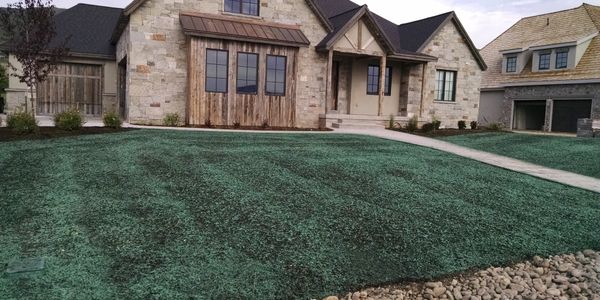Lawns &Grasses
Soil Preparation

The effort in the beginning to prepare the soil will directly reflect the appearance of the lawn for years to come. At the very least, we need a loose and raked surface, (1-2" of loose soil) free of existing vegetation. If you notice weeds or unwanted grass we recommend spraying with roundup or a generic that has glysophate. Once the weeds are dead go ahead and work the soil. If you are using existing soil, you may enhance it by adding mulch, wood chips, peat moss, leaf mold, sawdust, etc. If you are planning to bring in topsoil, a good soil is sandy loam. For best results make sure topsoil is mixed in with existing soil. This will ensure proper root development within your soil.
Watering Instructions

Watering is perhaps the most important aspect of grass development. Your job is to keep the mulch moist (not saturated) at all timesduring the day. This is best achieved by frequent but light watering. Normally 3-6 times a day between the hours of 9AM and 7PM. It is not a good idea to water at night as this will increase the formation of algae and seed rot, especially during the summer months. Water 1-4 minutes for stationary spray heads, 3-8 minutes for rotary gear driven heads. Be aware during times when it rains, it may not be necessry to water for one or two days. Watch the weather and adjust watering to keep the mulch moist. Over watering or puddles can create problems wth new lawns. Keep in mind sprinkler systems don't always have a 100% water coverage area, therefore hand water if necessary.
Fertilizing

Fertilize every 2-4 weeks with a starter fertilizer until grass is establish. Once established, fertilize every 6-8 weeks
throughout the first year with regular lawn fertilizer. Remember to water soon after you apply the fertilizer.
What about Weeds?
Weed seeds are present in all soil. Because of the optimum growing condition of hydroseeding, weed seeds will tend to take advantage of this by germinating. Weed seeds germinate faster than grass seeds. Do not be concerned when weeds appear. As the grass starts to establish, many weeds cannot survive the grass roots system. Proper maintenance of your lawn such as mowing and fertilizing will also control weeds. Do no apply a weed and feed or any kind of herbicide to the newly germinated lawn. After 60 days, an hebicide may be used.
Hydroseeding Quality?

The wonderful thing about hydroseeding is the fact you can pick and choose the type or variety of grass you would like in your yard. You are not limited to just one variety. Enviro-Systems of Utah offers many mixes and blends to fit your needs. These blends are of the highest quality for our area here in Utah. Some questions we might ask in finding the best seed for your situation might be, How much is your water bill? Do you have a sprinkler system? Where do you live? How much traffic will be on your new lawn? How often do you want to mow? How large of an area do you have? These are all questions that will help us pick the right seed for you.

Copyright © 2019 Utah Hydroseeding - All Rights Reserved.
Powered by GoDaddy Website Builder